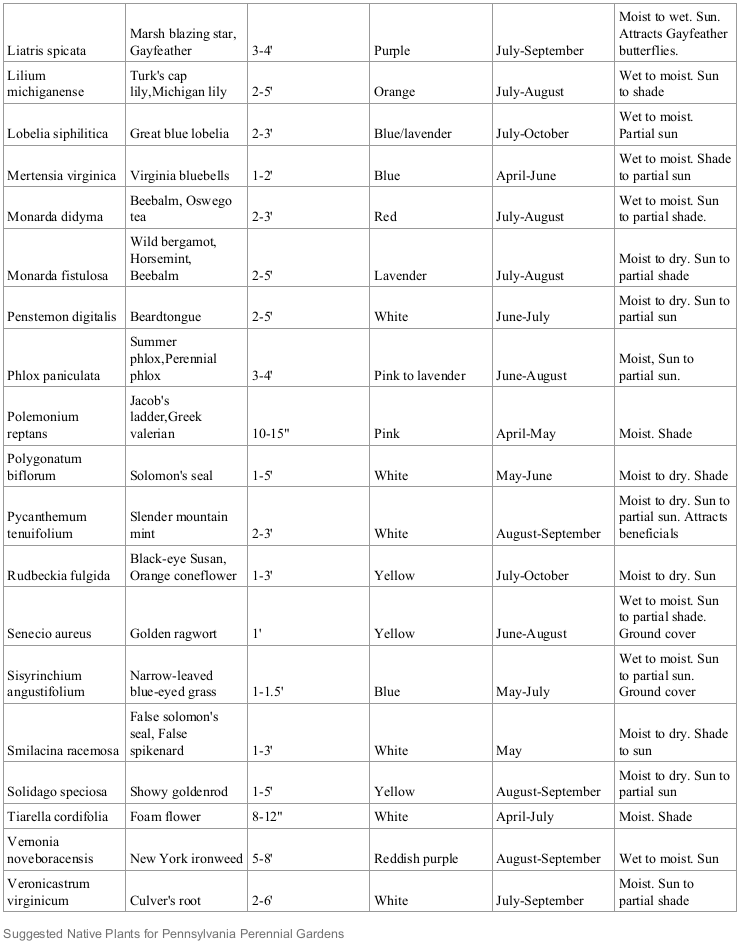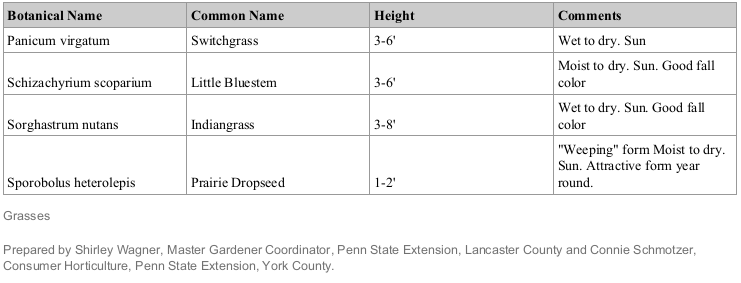Herbaceous (non-woody) perennial plants add year-round interest to any landscape and are a popular choice of plants among gardeners. Though thousands of perennials are available, native perennials have a special role in the garden.
Why Natives?
By definition, a native Pennsylvania plant is one that grew in Pennsylvania before the European settlers arrived, as opposed to exotic plants which came from other countries after that time period. Natives have many advantages. Because they evolved here, they are well-adapted to our climate and are generally easy to care for once they are established. Many native perennials like less fertile soil and require the addition of little or no fertilizer. Perhaps the most compelling reason to choose natives is to preserve Pennsylvania’s biodiversity. Development is rapidly reducing natural areas that shelter a wealth of our native plants; the landscapes that replace the natural areas consist mostly of lawns and exotic plants. Recent research from Dr. Doug Tallamy of the University of Delaware has determined that 90 percent of our native insects are specialists that feed on three or fewer families of plants. The insects rely on native plant hosts and cannot eat the exotic plants that have become common in our yards. A reduction of native insects means that birds have fewer insects to feed to their young, and that will lead to a reduction of bird species. In the next fifty years, what we plant in our yards will determine the kind of wildlife that can live in Pennsylvania. By planting natives, gardeners can help retain our natural history and the beauty and diversity of Penn’s Woods.
Choosing Native Perennials
Though native plants have the home advantage, matching their needs to the growing site is still very important. The soil around many of our home sites is often removed prior to home construction and may not be replaced afterward.
Determine your soil type. Do you have heavy clay or silty loam? Is it high or low in organic matter? Does it tend to dry out quickly after rainfall or does it hold moisture?
Other factors must also be considered. Is the site in sun or shade? How much room does the site allow for perennials to grow to their maximum size without crowding? Combining plants that grow well in the same natural habitats will help create healthy, vigorous plantings. If you do some homework and place plants in the proper environment, you will be rewarded with gardens that thrive with less care.
Note
Natives have many advantages. Because they evolved here, they are well-adapted to our climate and are generally easy to care for once they are established. Featured species: Chrysogonum virginianum.
Planting and Care
Spring, early summer, and fall are the best times to establish native perennials. Test your soil before planting and, if needed, amend the nutrients according to the soil test results. Remember that many natives do not require the addition of fertilizer and may do poorly in highly-fertilized soil. Plants that require moist soil high in organic matter will do well if compost is added. Cultivate the soil to a depth of eight to ten inches and incorporate any soil amendments.
When planting, placing the plant in a hole at the same depth as when it was in the container is important. If the plant is root-bound, make sure you free the root system by gently pulling it apart. Once the backfill soil is added, water the plant thoroughly. Additional water may be needed during the growing season until plants are well established. If planted in the proper environment, many natives need little or no additional water once established. In fact, many meadow species may become leggy if the soil is too moist. A two-inch mulch layer of shredded leaves, shredded bark, or compost will help conserve water. However, be sure to keep the mulch away from the plant stems.
Buying Native Perennials
Do not collect from the wild! Collecting plants from the wild causes the depletion of native species and disruption of the ecosystem. Be sure to purchase plants from a reputable source and purchase only nursery propagated native plants. Visit your favorite nursery or seek out native plant nurseries and sales sponsored by conservation societies. Native plants are becoming increasingly popular and easier to find. Your local Penn State Extension office can help.
Source
Lady Bird Johnson Wildflower Center Mid-Atlantic Recommended Native Plant Species List, 2001
This educational blog is a series of informative articles from the Penn State Master Gardeners volunteers plus news concerning the group and their activities. For more information, click here.









































